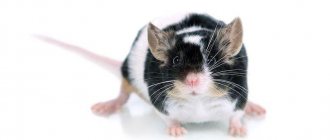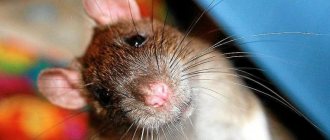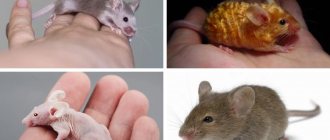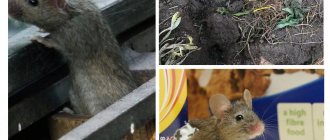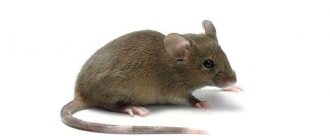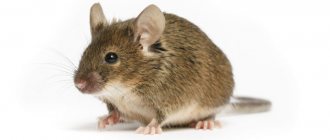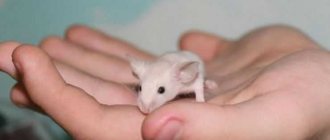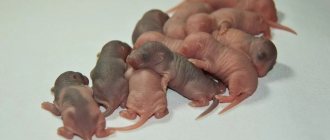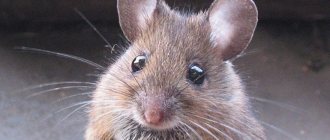When choosing a pet today, preference is increasingly given to such decorative types of rodents as satin mice. They are absolutely calm, friendly and quite unpretentious. However, this very gentle creature with unique fur can die due to hypothermia or extreme heat. And in order for a pet to delight you with its presence for a long time, you need to understand what its characteristics are and how to properly care for it.
What is the difference between a mouse and a rat (difference) - 5 differences, adults and babies
Mice and rats belong to the group of cosmopolitan species, which implies a wide distribution area of these mammals, which live in all corners of the planet, with the exception of mountainous areas and zones of the Far North.
Both of these species are characterized as synanthropic, that is, even wild members of the family live near human habitation, which facilitates access to food sources. Most people believe that the only difference between rats and mice is the difference in size. This is true, rats are large, but there are other differences that are worth considering in detail.
Diseases
Like all animals, mice can get sick. Basically, all diseases of ornamental mice arise from improper maintenance. For example, due to low humidity in the environment, a mouse can develop tail ring syndrome, where ring-shaped sores appear on the tail. Therefore, it is better to keep the cage where the humidity levels are 50-55%.
Mice also suffer from pneumonia, salmonellosis, which, by the way, can be transmitted to humans, mousepox, otitis media and many other diseases, and some of them, unfortunately, cannot be treated. It often happens that a mouse dies within two days during illness. Not all diseases can be seen by symptoms, but some symptoms need to be known because they are not typical for a healthy mouse, namely:
- weight loss;
- ulcers on the body;
- frequent urination;
- blood in stool;
- partial baldness.
It is important to monitor the animal’s living conditions and immediately contact a veterinarian if any of the above symptoms are detected.
What are the differences
A mouse and a rat have similar external characteristics. The main ones are: a pointed muzzle, the absence of thick hair on the tail, and the presence of sharp incisors that continue to grow throughout the life of the rodent.
But despite belonging to the same family and the presence of a number of external similarities, there is a difference between rats and mice
Differences between a mouse and a rat
To distinguish a mouse from a rat, you can consider not only an adult animal, but also a small representative of the species. Newborn rodents also have a number of external and behavioral characteristics inherent in representatives of a separate species.
The main differences between a baby rat and a mouse are:
- The difference between a rat and a mouse is the size of the tail. In the former, its length can be up to 110 percent of the body size, while the mice have a shortened tail, the size of which is no more than 60 percent of the body length.
- Small rodents have a round and less pointed head.
- To distinguish a rat from a certain mouse, you can look at its behavior. Small rodents prefer to eat, sit or sleep, huddled in a ball, while when gathering they behave freely.
The differences between mice and rats also lie in the characteristics of their fur : in small rodents it is softer and less dense.
Video
Funny animals. Mice and rats.
The main differences between domesticated rats and mice
Decorative rodents are widely popular as pets; they are clean, unpretentious, and do not require complex care.
The differences between domesticated rats and mice are as follows::
- The chromosome set of small rodents includes twenty-two chromosomes, while their large counterparts have only twenty. This feature makes it impossible to cross representatives of different species with the aim of subsequently producing offspring.
- Domestic rodents have a large body, the length of which is more than twenty centimeters, and the weight can reach six hundred grams.
- There are also external differences: the ears of small rodents are soft, rolled into peculiar little bags, while the ears of rats are dense and pointed.
- The body of small rodents is round, while large ones are long and elongated.
The lifespan of wild mice is no more than one and a half to two years. Domesticated rats, if cared for in accordance with the rules, live longer - up to three to four years.
Differences in intelligence
The main difference between a rat and a mouse is the level of intellectual ability. Large rodents, wild and domesticated, have remarkable intelligence.
They are careful, cunning, smart . It is extremely rare that these representatives of the rodent family fall into traps, and if this happens, the unlucky individual transmits a signal to the rest of the colony, thanks to which others will avoid the dangerous place.
Unlike mice, decorative rats are easy to train, they know their nickname and respond to it, they come up with games, attracting the owner to participate. They are sociable and love to spend time with people.
These unpretentious pets can be called companions. When buying a pet, you need to take into account its age, health, and habits of the animal.
Differences in nutrition
Mice and rats are omnivores. Their diet consists of cereals and vegetables, but at the same time they will not give up meat. Wild mammals have a peculiarity - they hunt in a whole flock, choosing as prey animals that significantly exceed them in size and body weight. This behavior is not typical for mice.
Origin story
Man first began to domesticate rodents even before our era, in the East. The breed of satin mouse was bred through selective breeding. Asia is considered to be its homeland, but the description was first given in the United States after an official exhibition in 1950 - this was the very first exhibition of domestic rodents in the world. After it, these events became very popular in the 50s of the 19th century. However, only rodents with an excellent pedigree could get on public display.
Did you know? In 1950, the first club of mouse lovers was created, which not only held exhibitions, but also set standards for various types of rodents.
What they look like
The difference between large and small representatives of the family is especially noticeable if each parameter of the animals’ external appearance is assessed separately.
Rats and mice look like this::
- Dimensions. The body length of large animals can be about thirty centimeters, while the length of the average mouse does not exceed ten centimeters.
- Mouse eyes are larger than rat eyes.
- Rat tails are longer, more massive at the base, and completely devoid of hair, while mice have hair.
- Rat muzzles are elongated and oblong.
The color of animal fur can vary depending on the species. Decorative rodents have different color options, with white and black colors being common.
Reproduction process
Within 3 months after birth, voles become sexually mature. In this case, only a few cubs are born, but an adult is capable of giving birth to about 12 cubs, which indicates the high fertility of rodents.
When the cubs are born, they still do not see anything, completely naked and helpless. During the first month, the female takes care of her offspring, after which the young individuals leave the nest of their parents. After this, they themselves begin to take care of their lives. In the photo below you can see what the cubs look like immediately after birth.
After giving birth, within a week and a half, the mouse is again ready for fertilization. As a rule, a vole becomes pregnant up to 4 times during a season.
Similarity in appearance
Mice and rats, despite belonging to separate species, have a number of similar characteristics.
These include:
- Lack of thick hair on the tail. The exception is the black rat; the tail of this animal is covered with thick hair.
- Round eyes black.
- Presence of sharp anterior incisors.
Similarities can also be identified according to the characteristics of behavior, nutrition, and lifestyle in general.
Breeding
House mice become sexually mature at 30-35 days of age. In females, estrus begins; in males, a sign of maturation is the prolapse of the testicles into the scrotum. Females are recommended to breed for the first time upon reaching three months of age.
Effective mating is possible only during estrus, which occurs in females every 3-8 days and lasts from 4 to 20 hours. Pregnancy in house mice lasts 22 days.
Around the middle of the gestation period, the female begins to build a house or nest out of the litter box in which the mice will remain after birth. Use shavings, scraps of soft fabric, paper, napkins as building materials
it is important to make sure that all this is available to the pregnant woman
There are from 5 to 9 mice in a litter. They are born naked, blind and deaf. The weight of a newborn mouse is 1-2 g.
Little mice develop quickly. On the third day there is hearing, on the fourth the whole body is covered with soft fur. By the fifth day of life, their body weight doubles. The eyes open two weeks after birth. From this age, domestic mice begin to feed on their own. Young animals are weaned from their mother on days 21-25.
To avoid uncontrolled reproduction, male house mice are separated from females.
Many people are not sure whether to get a pet mouse, because this animal has already gained fame. However, ornamental species of rodents make excellent pets: they are easy to care for, interesting to watch, mice are quickly tamed, and do not require special attention or high maintenance costs.
How to determine the type of spoiled food
You can also distinguish a mouse from a rat by the type of spoiled food.
If there are rodents in the house, you can determine their species according to the following behavioral characteristics:
- Cereals. When eating cereals, rats consume the grains without leaving any traces behind. Mice leave behind husks and spoiled grains.
- Small representatives of the family prefer to eat in only one place, while large ones cause serious damage to the household and food supplies, choosing new food sources each time.
If rodents have settled in the house, it is important to be able to determine their species, since control methods differ. To exterminate mice, you need to choose a trap or insecticides; to remove large rodents, you need to call professional exterminators, since these animals are extremely careful, cunning, and smart.
Breeding
Only breeders should breed gerbils. In addition to the difficulties that can arise during and after pregnancy, there is the problem of what to do with multiple children
Just as importantly, there are not many veterinarians who specialize in small rodents in most places. Therefore, there is a very high probability that you will not be able to help the rodent if complications arise.
It's interesting to read about breeding and breeding chinchillas as a business.
Mating
The concept of mating with gerbils is not very applicable, mainly because adults in the same cage will naturally mate in the near future. For gerbils, this is a grandiose event in terms of the volume of noise, when one after another they run around the cage, rustling intensely and stamping their feet.
Pregnancy and childbirth
There are many different signs of pregnancy, but not all of them are visible in the early stages. Therefore, it should be remembered that animals can reproduce from 3 months of age. And if a woman at this age has had contact with a man, most likely she is pregnant.
Signs of pregnancy:
- the lower half of their body has become much larger than the upper, and gradually the mouse takes the shape of a pear;
- the mouse gains weight;
- started building a nest.
Pregnancy usually lasts from 21 to 25 days. During this time, the female's behavior will change. He will become more vigilant and begin to kick others out of his nest. She does not need human assistance during childbirth. The mouse will give birth to 3-7 babies at a time. Their mother will feed them for a month.
Important! Unless you plan to keep your gerbils year-round, it is important to consider that, like many other rodents, they are ready to mate again the same day the babies are born.
Gerbils are born naked and with their eyes closed. The eyes will open on the 18th day, and then the teeth will appear. Children almost immediately begin to sharpen them, trying to chew cardboard, sawdust and pieces of food. But at this stage they depend on breast milk. They are weaned approximately 4 weeks after birth and placed on solid food. You can remove them from their mother when they are 6 weeks old.
How to care for little mice
At first, babies cannot regulate their body temperature, so it is important that the mother has and maintains the correct temperature in the nest. The mouse also takes care of the rest on its own.
It is useful to know how many years decorative house mice live.
If you notice your gerbil kicking or moving children, this is completely normal behavior for them and does not require intervention from their owners. It does not harm children. You may also notice that the male gerbil also takes care of his young. He keeps the nest clean and tidy, and when the curious babies start crawling, he gathers them back into the nest.
It's about the breed
In Daria Chesnokova's apartment there is a real zoo - birds chirp, mice scratch, cats meow. She began introducing us to her pets with a family of rodents. Mice with smooth, shiny, iridescent satin fur.
“They are a little larger than usual, they do not bite, unlike hamsters, they quickly get used to their hands and do not kill their offspring,” Daria briefly described her pets. – And satin mice live in families, just like people. Males help the female care for the offspring, warm the babies while the nursing mother rests and gains strength.
The adult mice, as if to confirm her words, settled comfortably on the palm offered by the mistress, enjoying the communication. But the little ones were not yet accustomed to human affection; when they saw Daria, they ran headlong to the corners.
“They are not born tame; small ones can bite,” explains the interlocutor. – Every evening I pick them up and stroke them to tame them. But they quickly get used to it.
As soon as the cage with mice was opened, the cat Snowball came running. I can’t imagine how he struggles with his instincts, but, according to Daria, he does not consider mice as food. From a young age I got used to playing with them. The second cat, Busya, also does not hunt rodents; a couple of times he even slept in a cage with small ones in his arms.
Daria's passion for mice began a couple of years ago, when she saw information on the sale of satin mice on a notice board in Novokuznetsk. They charmed the girl with their shiny fur, cute ears pressed to the head and kind eyes. I immediately ordered six animals from the capital of Kuzbass and three from the Omsk nursery. Yes, yes, in many Russian cities there are entire nurseries of ornamental mice, in which healthy, calm, human-oriented rodents are professionally bred. Rodent exhibitions are held in Moscow and St. Petersburg twice a year. Today Daria has about fifty mice - satin, rex with curly fur and ordinary mongrels. She sells her offspring all over the country.
“Decorative mice are not only distinguished by a calm disposition, they are unpretentious, easy to clean up after them, and feeding is simple,” Daria lists the advantages of pets.
Mice live in plastic containers with holes for air ventilation. According to the breeder, this is an ideal place to keep a rodent, as it protects the house from sawdust. And not every cage is suitable for little mice; they are nimble and can even slip through the bars.
Females and males, as a rule, live separately. The young are in one, the nursing ones are in the other, the elderly are in the third. In order to breed offspring, you should never put related mice in a cage. For her first litter, Daria deliberately ordered mice from different cities, so that relatives would certainly not get caught. Since such mice give birth to sick offspring with sparse hair, they quickly die.
Content requirements
Satin mice are not very expensive to keep. The only thing that needs to be broken is the cage. Mice are small but brave. They are active, love to run and jump, and willingly climb tunnels. And how they spin in the wheel, you have to see it. Because of their size, they sometimes drive together. One mouse runs in one direction, the other in the other. The wheel swings from side to side, and the satin mice, without letting go, begin to fix things.
Let's return to the topic of life.
- The cage has two or three floors. Requires tunnels, ladders and wheels. The minimum cage size is 40 x 50 x 35 cm.
- House. There are now plenty of homes for rodents. You can buy the cheapest one, the main thing is that the animal has a comfortable entrance.
- Filler. Some people recommend taking firewood or sawdust. We recommend corn. The thing is, Woody is very big. And it is very uncomfortable for a mouse to walk on it. Plus it crumbles when wet. This means that the urine begins to evaporate. The impurities it contains are harmful to the health of the mouse. Already on the second day after the change, the sawdust begins to smell. If you can't buy corn litter, cover the bottom of the cage with white paper.
- The simplest power supply. Take the smaller plastic one.
- Buy a hanging drinking bowl. You can get it with a metal stand, or you can choose a flush one. The latter is not particularly convenient, because the thread tends to break.
The cage has two or three floors. Requires tunnels, ladders and wheels. The minimum cage size is 40 x 50 x 35 cm.
House. There are now plenty of homes for rodents. You can buy the cheapest one, the main thing is that the animal has a comfortable entrance.
Filler. Some people recommend taking firewood or sawdust. We recommend corn. The thing is, Woody is very big. And it is very uncomfortable for a mouse to walk on it. Plus it crumbles when wet. This means that the urine begins to evaporate. The impurities it contains are harmful to the health of the mouse. Already on the second day after the change, the sawdust begins to smell. If you can't buy corn litter, cover the bottom of the cage with white paper.
The simplest power supply. Take the smaller plastic one.
Buy a hanging drinking bowl. You can get it with a metal stand, or you can choose a flush one. The latter is not particularly convenient, because the thread tends to break.
Here is a basic list of what you will need for a satin decorative mouse. Now let's talk about how to care for her.
Who else lives in Daria Chesnokova's apartment?
On the day we met, in the hallway of the Chesnokovs’ apartment we were greeted by cages with canaries on two floors. Daria said that they got them from a resident of Barnaul who was breeding canaries. Something happened in his life that he stopped caring about birds. She received 23 canaries in a terrible condition; it cost the woman a lot of strength to get them out. Most of the birds found good hands.
In addition to exotic birds, she also has forest birds - bee-eaters, goldfinches, bullfinches and even sparrows. Naturally, she did not catch them from the natural environment herself; the birds found salvation in her hands. For example, nurse sparrows. A resident of Barnaul found abandoned chicks, raised them, but could not keep them for a long time, since she had a cattery at home. In the wild, the chicks could die. Daria took them into her feathered flock.
Features of feeding
The basis of the diet of the satin rat is wheat. Pet stores sell mixtures containing millet, barley, buckwheat, wheat, oats and seeds. Your pet needs 1 teaspoon of food per day.
In addition to cereals, you can give vegetables and fruits:
- carrot;
- broccoli;
- cucumber;
- zucchini;
- cauliflower;
- apple.
In summer, you can pamper your satin rat with fresh herbs; it is a good source of vitamins and amino acids. The animal will not refuse dandelion and plantain leaves. Once a week, the mouse is offered boiled poultry fillet.
Prohibited products include:
- sweets;
- pastries, bread;
- white cabbage, turnip;
- mushrooms;
- horseradish;
- garlic;
- bananas;
- citrus;
- dried fruits (they contain a lot of sugar);
- cheese;
- potato;
- potato chips, crackers, snacks;
- salty, fried, fatty foods from the human table.
Who to choose - decorative mice or decorative rats?
Rats need a lot of space, companionship and love. Mice are less whimsical. You will have to keep the rats in shape yourself; mice only need a wheel in a cage. Rats need to be walked for several hours a day (on the sofa, for example), mice live well in a cage. Rats happily and enthusiastically hide in the smallest cracks; mice often do not even have this opportunity (they are less likely to leave the cage). Male rats have only a slight smell of urine; mice of either sex have a much stronger smell. Rats can (but not always) mark everything they can reach; this habit is less common in mice. Rats will greet you with great joy, even if you are away for a couple of minutes, the mice view you as an automatic feeder. You can play with rats, teach them tricks, they are very nimble and funny, in most cases you can only look at mice. They live about the same. I needed pets with whom I could communicate and who would be happy to see me, so I chose rats for myself and I don’t regret it at all. With mice, most likely, there would be less worries, but with them (for me personally) it would not be so interesting. Regarding the answer above: I’ve been studying forums about rats for a long time, but I haven’t come across such information anywhere. On the contrary, it is believed that females are more tame and calm than males. And my two guys are constantly trying to get out of the cage, one is gnawing on the bars in one place, the other is rushing at full speed, you just have to open the door a little. The one that gnaws marks me, the sofa, the floor every time, and the second one, even though he walks anywhere in a cage, does not allow himself to do this when walking. I will also note that rats tend to get sick easily, so you will have to tinker with them. It is imperative to cover the lattice floors of the cage, otherwise corns will appear, which will later begin to bleed and fester; the same can happen when using wood filler. They get cold easily, so drafts should never be allowed. At 4-6 months it is better to castrate the baby rat, regardless of the gender, this will reduce the risk of developing cancer. If you have a baby Dumbo, he will cheer you up, you just have to look at his face.
Choose the one who suits you best. If you are not ready to devote time to caring for a pet, then these are definitely mice, but if this does not scare you, and you want to communicate with animals, then rats are the best option. And don't forget that one animal will be lonely.
Source
Maintenance and care
The mouse can be kept at home in a fine-mesh metal cage, as well as in a special plexiglass container with a lid. This is necessary because mice jump beautifully. The terrarium or cage should be spacious enough, since animals are very active and need to move. Strips of undyed paper or shavings are used as bedding. A house (a jar, a box, a vase, etc.) is installed in the cage, in which the mice will arrange a nest, a drinking bowl, a manger, a piece of plaster and other devices for games. Stairs, levels, shelters, branches are suitable for this; it is also recommended to install a running wheel.
Place the terrarium or cage as far as possible from windows, radiators, air conditioners and doors, as pets do not like temperature changes, direct sunlight and drafts. The optimal air temperature is 20 ° C with an air humidity of 55%. Every day, debris and leftover food are removed from the cage, and the feeders and drinking bowls are washed. The bedding is changed three times a week, and at least once a month the terrarium or cage must be completely disinfected and cleaned. Mice feces have an unpleasant, pungent odor. Moreover, females have a much weaker odor than males.
In the terrarium, it is recommended to install pieces of large tree branches directly with the bark (birch, willow, rowan) so that the animals can grind their incisors on them. Please note that lilac is poisonous to these animals. You can also put wooden toys in the cage so that the animal can play while grinding its incisors. With proper placement, pet rats do not need walks. If the animal does go out for a walk, the place for its walks must be limited to the owner’s hands or a table. It should be remembered that various indoor plants are poisonous to mice, including aralia, yucca, poinsettia, feces, etc.
When breeding several animals at the same time, it is advisable to create same-sex groups: 2-3 males or 2-3 females living in a common cage get along well. At the same time, those who belong to the same family tree live better. Newborns should not be touched and it is not advisable to disturb the mother.
Such mice are evening and nocturnal animals; they can interfere with sleep by creating noise and various sounds, although they mainly adapt to the human regime.
